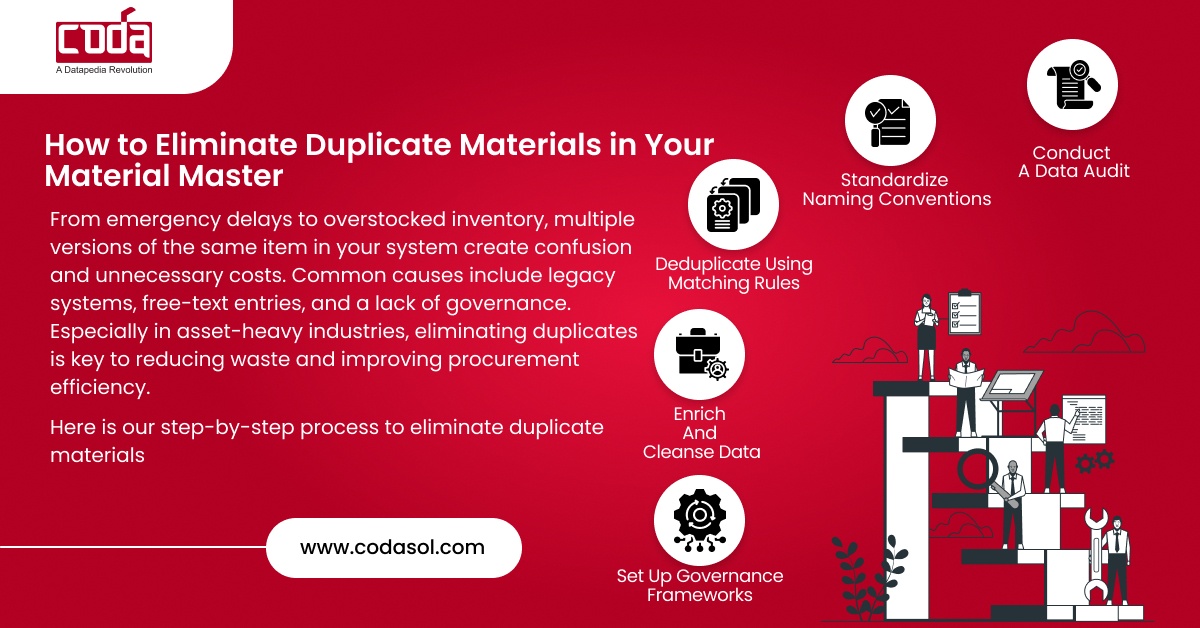The Hidden Cost of Duplicate Materials and How to Eliminate Them
Imagine you’re trying to source a critical spare part during an emergency shutdown. Your system shows five entries for the same item, each with different names, descriptions, and prices. Which one do you pick? Eliminate duplicate materials.
Duplicate materials in your material master inflate inventory, delay procurement, and cause stockouts or overstocking. For asset-heavy industries like Oil & Gas, EPC, Manufacturing, and Utilities, this leads to millions in avoidable costs annually.
In this guide, you’ll learn how to eliminate duplicate materials from your material master, step by step. Whether you operate in India, the GCC, or Southeast Asia, this is your roadmap to cleaner data and a smarter supply chain.
Why Duplicate Materials Exist
Before solving the problem, understand why it happens:
- Multiple ERPs or legacy systems: Each system may have created its own version of the same material.
- Decentralized procurement: Different teams or sites create their own material codes.
- Lack of governance: No approval workflows or master data ownership.
- Free-text entries: Human error and inconsistent naming conventions.
- Unstructured historical data: Old records are never cleansed or archived.
The result? Redundancy, confusion, and cost.
What’s the Impact?
Here’s how duplicates quietly destroy supply chain efficiency:
| Area | Impact of Duplicates |
|---|---|
| Inventory Cost | Excess stock due to misidentified material needs |
| Procurement Delays | Wasted time sourcing the right part |
| Supplier Duplication | Missed volume discounts & price negotiations |
| Asset Downtime | Delays in maintenance from material mismatches |
| Financial Reporting | Skewed spend analytics and budgeting |
For example, a materials audit for a steel manufacturer in Saudi Arabia revealed 18% of their 85,000 material codes were duplicates. That’s over 15,000 redundant entries, costing them approximately $2.7 million in annual inventory carrying costs.
Step-by-Step: How to Eliminate Duplicate Materials
1. Conduct a Data Audit
Start with a material master health check. Identify duplicates using:
- Exact and fuzzy matching algorithms
- Synonym dictionaries (e.g., “gasket” vs. “seal ring”)
- Description parsing (short and long texts)
- Cross-reference units, part numbers, and manufacturers
Tip: Use AI/ML-powered tools to automate this at scale.
2. Standardize Naming Conventions
Adopt a universal naming template such as:
<Material Type>_<Material Description>_<Size/Spec>_<Manufacturer>
Example: GASKET_CIRCULAR_NBR_10INCH_DANA
This helps differentiate materials while maintaining consistency.
- Create a Material Description Dictionary
- Use international standards like UNSPSC or ISO 8000
3. Deduplicate Using Matching Rules
Set clear criteria to define duplicates:
- Exact Match: Same part number, description, and UoM
- Near Match: Similar description or overlapping spec
- Functional Match: Can be used interchangeably despite minor differences
Deduplicate at three levels:
- System Level: Merge or deactivate duplicates in the ERP
- User Level: Train users to search existing items before creating new ones
- Process Level: Integrate de-duplication in material creation workflow
4. Enrich and Cleanse Data
Enriched data helps prevent duplication by:
- Providing complete specs and manufacturer details
- Mapping alternative part numbers and OEM references
- Using images, datasheets, and technical drawings
Tools like PROSOL offer built-in capabilities for material data enrichment and governance.
5. Set Up Governance Frameworks
Without governance, duplicates will creep back in. Define:
- Roles & responsibilities: Data Stewards, Approvers, Requestors
- Approval workflows: Every new material undergoes review
- Data quality rules: Consistency, completeness, uniqueness
- Periodic audits: Quarterly or bi-annual data checks
How PROSOL Helped a Client Save $3.4 Million
A Qatar-based petrochemical company had over 110,000 materials in their ERP. Through a deduplication project using CODASOL’s PROSOL platform, they:
- Identified and eliminated 16,000 duplicate entries
- Standardized naming and descriptions
- Integrated governance into their SAP environment
Result:
- Inventory value reduced by 12%
- Procurement cycle times dropped by 18%
- ROI achieved in under 5 months
Clean Your Material Master Before It Costs You More

You may be losing millions without realizing it. Get a free Material Master Health Check and find out how many duplicates are sitting in your system.
How to Prevent Duplicates Going Forward
Prevention is just as critical as elimination.
Implement a Golden Record Approach
Maintain a “single source of truth” by integrating:
- Master Data Management platforms
- Cross-plant material code visibility
- AI-based search during material creation
Train Your Teams
Equip procurement, stores, and maintenance teams with:
- Search best practices
- Material creation do’s and don’ts
- Quick-reference guides for naming conventions
Integrate with ERP and Procurement Tools
Make material master integrity part of your ERP strategy:
- Embed search before creation logic
- Use drop-downs and restricted fields
- Leverage AI to suggest existing materials
Ready to Build a Clean, Governed Material Master?
Talk to our experts and explore deduplication, enrichment, and governance tools tailored for your industry.

FAQs
1: What is a duplicate material in SAP or ERP systems?
A duplicate material refers to multiple entries in the system for the same physical item, often with slightly different names, specs, or units. These create confusion and inefficiency in inventory and procurement.
2: What tools can identify and eliminate duplicate materials?
You can use MDM platforms like PROSOL. It uses fuzzy matching, AI, and rule-based engines to identify and clean duplicates.
3: How often should I audit my material master?
Ideally, perform an audit quarterly. If your operations are highly dynamic or decentralized, monthly audits may be more effective.
4: Can duplicate materials be merged without losing transaction history?
Yes. Most modern ERPs allow merging or linking material records while preserving transaction logs. Alternatively, obsolete codes can be marked inactive.
5: What are the risks of not deduplicating material masters?
Risks include:
- Inflated inventory carrying costs
- Delayed maintenance and production
- Ineffective spend analysis
- Procurement delays and supplier issues

